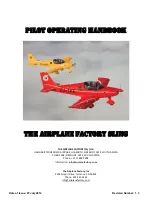
11
hand. With a decent wind it is by far the best way. In weaker wind it
is better to prepare a classic launch, as running backwards with an
engine on your back is not an easy thing to do.
It is reasonable not to pull the wing up until you are really
determined to launch, especially when it is clipped in.
Lay down the rolled paraglider with its trailing edge against the
wind. Unfold the wing enough to find the risers and check that no
lines are looped over the leading edge. Stretch the risers against the
wind, separating the right and left one.
We suggest that you lay the risers in the same way as you will be
turning during reverse launch, and place one riser over the other,
with rear risers upmost. It should be done this way because once
you clip in, the cage of your power unit will make turning on your
own practically impossible. Now run the pre-launch checklist.
After warming up the engine put the power unit on, turn to face the
wing, go to the risers and clip them in the appropriate carabiners.
Pulling on the front and rear risers open the cells. It is a good idea
to pull up the wing briefly in order to check that the lines are not
tangled. Holding the risers, brakes and throttle as described above,
pull the front risers and raise the canopy over your head.
Once you have it overhead, turn around, open the throttle and take
off.
Remember:
<
You are launching with your hands crossed. You have to really
master this technique before trying it with a running engine on
your back.
<
Any brake operation (or steering inputs in general) should be
smooth and gentle.
<
Do not try to take off until you have your wing overhead. Hitting
the gas pedal before that can cause dangerous oscillations.
<
Do not sit in the harness until you are sure you are flying!
<
The faster the trim setting is, the more brake input is required to
take off.
Important:
When clipping in the crossed risers, you can find
proper connection of the speed system particularly hard. Be
careful not to confuse the risers!
launch
!






























